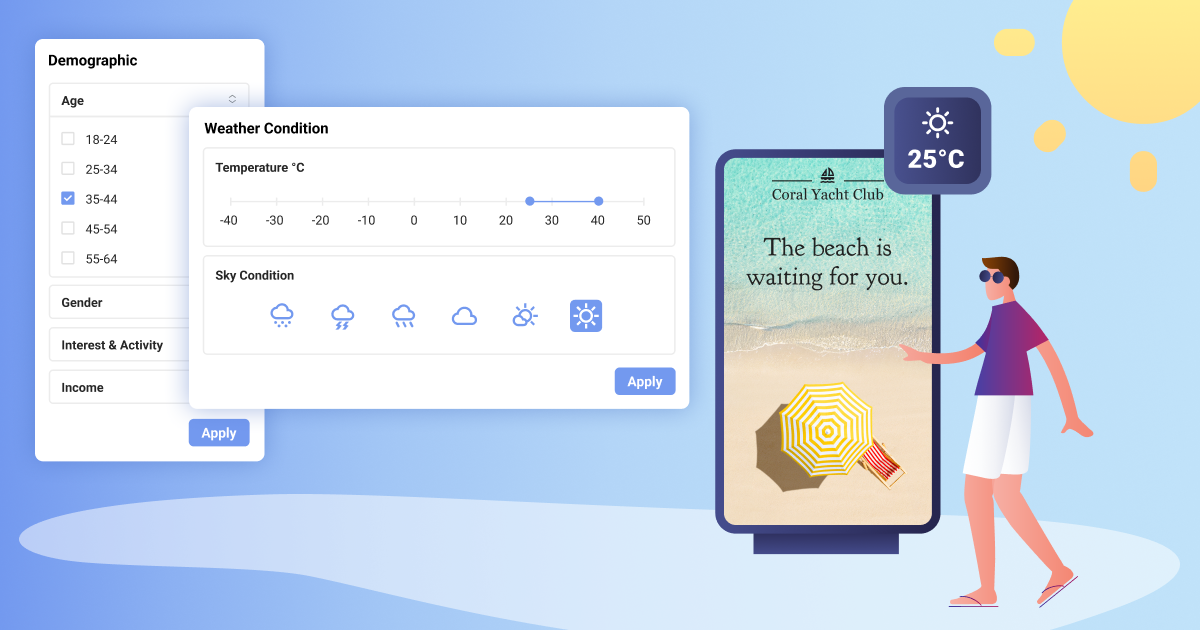
Broadsign Makes New Data-Centric Ad Server Generally Available To DOOH Network Operators
May 16, 2023 by Dave Haynes
DOOH-focused software firm Broadsign has announced the “general availability” of the Broadsign Ad Server that it first started talking about back in January at Integrated Systems Europe.
The new software, says the Montreal company, “gives OOH media owners access to modern tools for selling, improved targeting capabilities, and advanced reporting in direct, one-to-one selling environments.”
Broadsign said earlier this year that the reworked platform includes unified access to existing Broadsign product subscriptions, audience-based campaign targeting, and expanded static signage operations – the static/print support a nod to some of the capabilities available via Ayuda Media Systems, which Broadsign acquired in 2019.
The ad server set-up is also a nod to demands for highly contextual and real-time ad targeting. The software company has always been heavily about doing rules-based scheduling and targeting, and presumably this new ad server takes full advantage of all the APIs and is likely future-proofed for integrating Web3 stuff like secure payments.
From the PR (Warning: AD JARGON AHEAD!) …
It releases as more digital and omnichannel buyers have entered the OOH advertising ecosystem, impacting advertiser and media buying agency demands. Buyers are increasingly adopting an audience-based approach to OOH, making it crucial for OOH media owners to leverage their inventory to help buyers reach target audiences at the right moment with data-driven demographic selections and contextual triggers. At the same time, they demand more flexible OOH campaign activation and delivery, comparable to other familiar digital ad mediums.
To this end, packaging, and pricing OOH inventory in multiple ways, operating different monetization channels, and adjusting to alternative campaign objectives and delivery methods have become paramount to meeting modern media buyer needs and expectations. These new ways of working, however, introduce new complexities, which require new tools like those offered by the Broadsign Ad Server.
Audience-based and contextual targeting capabilities to direct selling
While programmatic digital out-of-home (pDOOH) enables media owners to deliver audience-based and contextual campaigns, direct sales still represent over 85% of all DOOH ad spending. For audience-based advertising to see broad adoption in OOH, media owners must support demographic and contextual targeting in a direct selling environment.
Advertisers have often had access to better targeting tools than OOH campaign planners, but the Broadsign Ad Server challenges that history, providing media owners with the same flexibility and comprehensive targeting capabilities. A complement to existing direct selling tools, it lets users easily set audience and targeting requirements based on demographics, points of interest, weather, and more so they can close deals quicker.
With the Broadsign Ad Server, OOH ad campaigns are dynamically served based on real-time inventory availability and assigned contextual triggers, like audience demographics, weather, or financial market movements, ensuring that ads are delivered to the right audience at the best possible moment. With access to added flexibility and better targeting tools, Broadsign Ad Server users can sell impression-based campaigns around frequency campaigns, maximizing screen fill rates.
The addition of ad serving capabilities to the Broadsign platform makes it easier than ever to plan, execute, and monitor guaranteed, programmatic, and audience campaigns in one single place. Moreover, Broadsign’s solutions are designed to help media owners get the most out of their inventory. When used together, the Broadsign Ad Server and Broadsign Platform allow OOH media owners to further maximize fill rates by selling impression-based campaigns around frequency, as well programmatic ones.
Broadsign’s guaranteed campaign tools also provide traditional one-to-one sales, and various fixed and flexible campaign types, like impressions and spot-based campaigns; they are guaranteed to deliver based on attributed goals, objectives, and pre-selected screens. Complementing a direct sales strategy, the Broadsign Programmatic (SSP) increases the potential exposure to a media owner’s inventory by making screens visible to buyers across more than 30 of the largest DSPs worldwide.
The Broadsign Ad Server lets sales teams continue to enjoy the benefits of one-to-one sales with the addition of sophisticated targeting tools like demographics, points of interest and moments, and ad serving capabilities to play campaigns in real-time based on network availability and contextual triggers.



Leave a comment